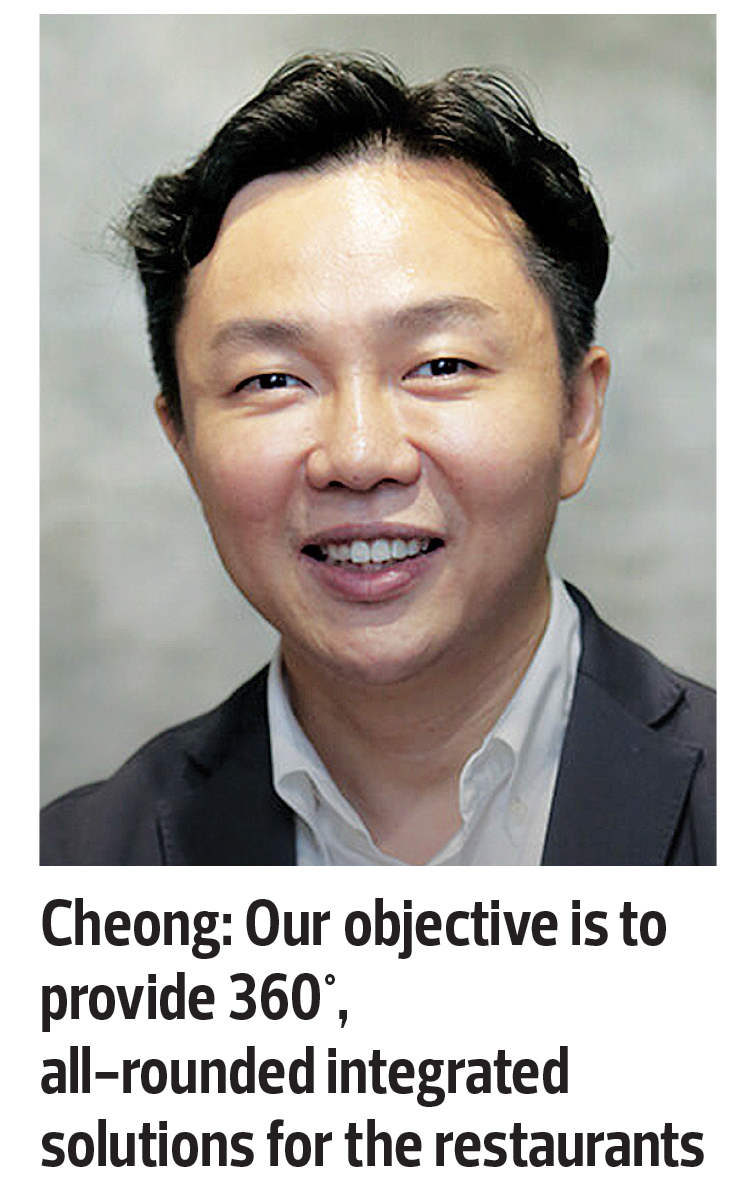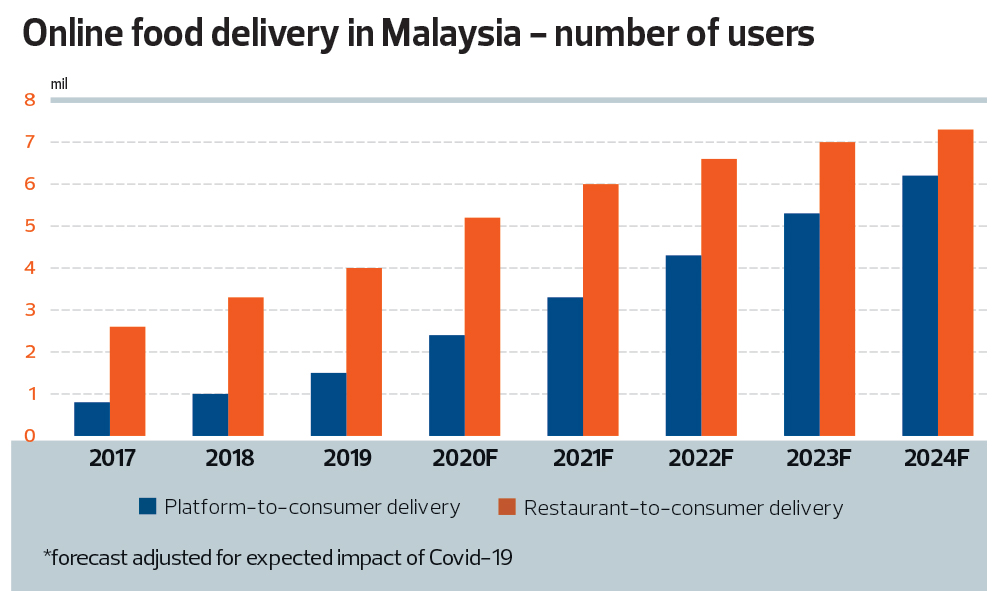
Hungry, one of PUC’s partners, has more than 18,000 registered merchants and over 7,000 registered riders
This article first appeared in The Edge Malaysia Weekly on August 17, 2020 - August 23, 2020
IN the wake of the Covid-19 pandemic that has transformed our lifestyle, including our food-ordering habits, many food and beverage (F&B) businesses in Malaysia are shifting to providing online food delivery and takeaway services.
According to statistics portal Statista.com, the revenue of Malaysia’s online food delivery sector is projected to reach US$211 million (RM884.8 million) this year, of which US$150.3 million will be contributed by restaurant-to-consumer delivery.
Between 2020 and 2024, the sector’s revenue is expected to see an annual growth of 18%, resulting in a market volume of US$410 million by 2024.
Basically, the restaurant-to-consumer delivery segment involves the delivery of meals by the restaurants themselves. The orders may be made via platforms or directly through the restaurant’s website.
Then there is the platform-to-consumer delivery market segment, which focuses on online delivery services that provide customers with meals from partner restaurants that do not necessarily have to offer food delivery services themselves. In this case, the platform handles the delivery process.
Noting that online food delivery services are expected to become a permanent business segment in the F&B sector, even post-pandemic, PUC Bhd group managing director and CEO Cheong Chia Chou saw a few gaps in the F&B supply chain and decided to work towards filling them.
“The information analysis gathered for F&B businesses starts with the point of sale (POS), which contains most of the crucial data of a restaurant’s business. However, most of these [food delivery] platforms, which are provided by third parties or food delivery companies, were never integrated with the POS, as this business segment was never a key consideration for the F&B businesses,” he explains.
“Our objective is to provide 360°, all-rounded integrated solutions for the restaurants, allowing them to not only provide food delivery via third-party platforms but also through their own branded platforms,” Cheong tells The Edge in an interview.
Besides food delivery, similar features are also available for dine-in, takeaway, self-pick-up and drive-through services, he adds.
Tripartite business collaboration
In June, ACE Market-listed PUC — via its lifestyle app Presto — teamed up with Main Market-listed POS systems provider Cuscapi Bhd and food delivery platform Hungry to set up an online management suite for F&B companies.
According to Cheong, the fully integrated and digitalised cloud-powered F&B management suite initiated by PUC, dubbed Custory, is designed to help F&B operators manage the order-to-delivery cycle, among others.
“This new platform is composed of food ordering, cashless payments and delivery, each of which is the speciality of Cuscapi, Presto and Hungry respectively,” he says.
Hungry, which was started in May 2018, has more than 18,000 registered merchants and over 7,000 registered riders. Its coverage areas include the Klang Valley, Nilai, Ipoh, Kluang, Langkawi, Penang, Kuantan, Sibu, Miri, Kuching and Kota Kinabalu.
Cheong says the tripartite business collaboration is essentially about connecting all the parties involved in the whole F&B supply chain, namely the F&B operators, suppliers, food delivery providers and end-customers.
“In the near future, we will be connecting the F&B operators to not only their customers (B2C) but also their suppliers (B2B). Together, we can help the restaurants monitor their supplies, helping them to forecast the use of their stocks and arrange just-in-time delivery of raw ingredient supplies.”
He highlights that Cuscapi’s area of strength is that its POS systems are used by tier-1 restaurant chains and it is strong in the provision of technology solutions, whereas Presto plays a crucial role in the payment space.
“The advantage of working with Presto is that we already have a very comprehensive suite of payment facilitation, and we could help the restaurants bring in many loyalty partners such as BonusLink and BIG Loyalty. We could also create a loyalty programme for the restaurants themselves,” says Cheong.
“Our objective is to give the best prices to the F&B operators and end-customers. The restaurants no longer need to go through the hassle of keeping stock in their fridges, or sending their staff to buy supplies at the supermarkets. We can ensure that the food supplies are always fresh, timely and at the lowest prices.”
Too many PDA devices
Typically, restaurants receive a personal digital assistant (PDA) device — on which they receive food orders — from each of the food delivery companies that they work with. One problem is that these orders are not integrated with the restaurants’ POS and, hence, they would have to do separate reconciliation of all these orders.
“Currently, you need to have a dedicated staff in the restaurant to make sure that whatever orders that are shown in the PDA devices are promptly processed,” says Cheong.
He points out that many restaurants were desperate when the pandemic hit and, as a result, signed up with as many food delivery partners as possible.
“That’s when things became chaotic. They now have too many PDA devices. It is too disorganised, from the accounting and operations perspectives. That’s why we need to have an integrated solution to combine all these PDA devices into the POS, so that the restaurant staff can have a single, consolidated view of the whole operations,” Cheong elaborates.
With an integrated solution, the orders can also be sent to the kitchen display or order systems, so that the chef can prepare the food accordingly, he adds.
Cheong says there are many potential ways to optimise the cost of every single component in the food delivery process, from order and payment to rider arrangement. For instance, the rider usually needs to wait at the restaurants or for the customers. The waiting time is stopping him or her from earning more money by making more trips.
Meanwhile, many third-party food delivery platforms charge higher fees because they need to put aside funds for marketing, to drive consumers to try their services.
Venturing into the F&B space
PUC is establishing its presence in the F&B space, on top of the e-commerce space, and this will essentially help increase the number of transactions for its payment services, says Cheong.
“PUC works with Cuscapi and Hungry closely to tap into their existing customer and F&B merchant base. Today, Presto has more than 10 million users via multiple partnerships. In future, our customers will be able to get their ordered items within the next day too,” he continues.
By working together with Cuscapi and Hungry, Cheong is confident that the three firms will be able to continue increasing their merchant and user base. “We are targeting to penetrate 1,000 F&B outlets by the end of this year and, conservatively, we expect to triple that by end-2021.”
He adds that the market potential in Malaysia is huge, considering that there are more than 100,000 F&B outlets in the country. “What we are looking at currently is only 1% of the market.”
Based on preliminary data and estimates, the transaction volume of Custory is expected to be significant, Cheong remarks.
Conservatively, Custory is expected to generate an estimated total transaction volume of RM1 billion per annum.
“From this, PUC will be able to enjoy revenue contributions and profit margins through Presto. If we could penetrate into more outlets and gain more active users, the numbers will be bigger. We expect to see financial contributions starting from the fourth quarter of this year. The full-year contribution will be reflected next year,” says Cheong.
In the financial year ended Dec 31, 2019 (FY2019), PUC slipped into the red with a net loss of RM58.78 million, on revenue of RM47.03 million.
The counter has risen by two sen or 8.9% year to date, closing at 24.5 sen last Wednesday and giving the company a market capitalisation of RM151.2 million.
Meanwhile, RedHot Media International Ltd (RHM) has ceased to be a substantial shareholder of PUC. In a filing last Wednesday, PUC said RHM’s stake had been diluted following the private placement of 142.42 million shares, which was completed on Aug 10.
It is unclear if a new substantial shareholder will emerge after the share placement.
RHM is the private vehicle of Cheong, who took over the helm from his late brother, Cheong Chia Chieh, in 2017.
Save by subscribing to us for your print and/or digital copy.
P/S: The Edge is also available on Apple's App Store and Android's Google Play.
- Musk’s xAI start-up swallows up X social network in surprise deal
- Seeking opportunities in a risk-off market
- Zelenskiy cautious about new minerals deal but says past US aid not a loan
- World Economic Forum highlights EPF as model for sustainable retirement reform
- Stocks lose ground amid inflation, trade war worries; gold at record high
- U Mobile secures MCMC award, gears up for nationwide 5G roll-out
- Indonesians feeling market gloom ahead of major holiday
- South Korea's ex-president Moon summoned for graft questioning, Yonhap reports
- US FCC chairman orders DEI investigation into Disney, ABC
- Airbus wins £150m contract to land European rover on Mars


